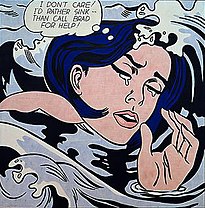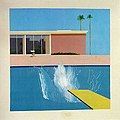Pop Art is a visual art movement that emerged in the mid 1950s in Britain and in parallel in the late 1950s in the United States. [1] Pop Art challenged tradition by asserting that an artist's use of the mass produced visual commodities of popular culture is contiguous with the perspective of Fine Art since Pop removes the material from its context and isolates the object, or combines it with other objects, for contemplation. [1] [2] The concept of Pop Art refers not as much to the art itself as to the attitudes that led to it. [2]
Pop Art is one of the major art movements of the twentieth century. Characterized by themes and techniques drawn from popular mass culture, such as advertising,comic books and mundane cultural objects, Pop Art is widely interpreted as a reaction to the then-dominant ideas of Abstract Expressionism, as well as an expansion upon them. [3] Pop Art, like pop music, aimed to employ images of popular as opposed to elitist culture in art, emphasizing the banal or kitschy elements of any given culture, most often through the use of irony. [2] It has also been defined by the artists' use of mechanical means of reproduction or rendering techniques.
Much of Pop Art is considered incongruent, as the conceptual practices that are often used make it difficult for some to readily comprehend. Pop Art and Minimalism are considered to be the last Modern Art movements and thus the precursors to Postmodern Art, or some of the earliest examples of Postmodern Art themselves.[4]
Origins
The origins of Pop art in America and Great Britain developed slightly differently. [2] In America, it marked a return to hard-edged composition and representational art as a response by artists using impersonal, mundane reality, irony and parody to diffuse the personal symbolism and ″painterly looseness″ of Abstract Expressionism. [3] [5] By contrast, the origin in post-War Britain, while employing irony and parody, was more academic with a focus on the dynamic and paradoxical imagery of American popular culture as powerful, manipulative symbolic devices that were affecting whole patterns of life, while improving prosperity of a society. [5] Early Pop Art in Britain was a matter of ideas fueled by American popular culture viewed from afar, while the America artists were inspired by the experiences of living within that culture. [5] However, Pop Art also was a continuation of certain aspects of Abstract Expressionism, such as a belief in the possibilities for art, especially for large-scale artwork.[3] Similarly, Pop Art was both an extension and a repudiation of Dadaism.[3] While Pop Art and Dadaism explored some of the same subjects, Pop Art replaced the destructive, satirical, and anarchic impulses of the Dada movement with detached affirmation of the artifacts of mass culture.[3] Some of the most influential proto-Pop artists include Pablo Picasso, Marcel Duchamp, Kurt Schwitters, and Man Ray amongst others.
In Britain: The Independent Group

The Independent Group (IG), founded in London in 1952, is regarded as the precursor to the Pop Art movement. [1] [6] They were a gathering of young painters, sculptors, architects, writers and critics who were challenging prevailing modernist approaches to culture as well as traditional views of Fine Art. The group discussions centered around popular culture implications from such elements as mass advertising, movies, product design, comic strips, science fiction and technology. At the first Independent Group meeting in 1952, co-founding member, artist and sculptor Eduardo Paolozzi presented a lecture using a series of collages titled Bunk! that he had assembled during his time Paris between 1947-1949. [1] [6] This material consisted of 'found objects' such as, advertising, comic book characters, magazine covers and various mass produced graphics that mostly represented American popular culture. One of the images in that presentation was Paolozzi's 1947 collage, I was a Rich Man's Plaything, which includes the first use of the word “pop!″, appearing in a cloud of smoke emerging from a revolver. [1] [7] Following Paolozzi's seminal presentation in 1952, the IG focused primarily on the imagery of American popular culture, particularly mass advertising. [5]
Subsequent coinage of the complete term “Pop Art” was made by John McHale for the ensuing movement in 1954. “Pop Art” as a moniker was then used in discussons by IG members in the Second Session of the IG in 1955, and the specific term “Pop Art” first appeared in published print in an article by IG members Alison and Peter Smithson in Arc, 1956 [8]. However, the term is often credited to British art critic/curator, Lawrence Alloway in a 1958 essay titled The Arts and the Mass Media, although the term he uses is "popular mass culture" [9] Nevertheless, Alloway was one of the leading critics to defend mass culture and Pop Art as a legitimate art form.
In the United States
Begun in the late 1950s, Pop Art in America was given its greatest impetus during the 1960s. By this time, American advertising had adopted many elements and inflections of modern art and functioned at a very sophisticated level. Consequently, American artists had to search deeper for dramatic styles that would distance art from the well-designed and clever commercial materials. [5] As the British viewed American popular culture imagery from a somewhat removed perspective, their views were often instilled with romantic, sentimental and humorous overtones. By contrast, American artists being bombarded daily with the diversity of mass produced imagery, produced work that was generally more bold and aggressive. [6]
Two of the most important painters in the establishment of America's Pop Art vocabulary were Jasper Johns and in particular Robert Rauschenberg. [6] While the paintings of Rauschenberg have obvious relationships to the earlier work of Kurt Schwitters and other Dadaists, his concern was with society of the moment. His approach to create unity out of ephemeral materials and topical events in the life of everyday America gave his work a unique quality. [6] [10]
Of equal importance to American Pop Art is Roy Lichtenstein. His work probably defines the basic premise of Pop Art better than any other through parody. [6] Selecting the old-fashioned comic strip as subject matter, Lichtenstein produces a hard-edged, precise composition that documents while it parodies in a soft manner. The paintings of Lichtenstein, like those of Andy Warhol, Tom Wesselmann and others, share a direct attachment to the commonplace image of American popular culture, but also treat the subject in an impersonal manner clearly illustrating the idealization of mass production. [6]
It should also be noted that while the British Pop Art movement predated the American Pop Art movement, there were some earlier American proto-Pop origins which utilized 'as found' cultural objects.[3] During the 1920s American artists Gerald Murphy, Charles Demuth and Stuart Davis created paintings prefiguring the Pop Art movement that contained pop culture imagery such as mundane objects culled from American commercial products and advertising design.[11][12][13]
In Spain
In Spain, the study of Pop Art is associated with the "new figurative." which arose from the roots of the crisis of informalism. Eduardo Arroyo could be said to fit within the pop art trend, on account of his interest in the environment, his critique of our media culture which incorporates icons of both mass media communication and the history of painting, and his scorn for nearly all established artistic styles. However, the Spaniard who could be considered the most authentically “pop” artist is Alfredo Alcaín, because of the use he makes of popular images and empty spaces in his compositions.
Also in the category of Spanish Pop Art is the “Chronicle Team” (El Equipo Crónica), which existed in Valencia between 1964 and 1981, formed by the artists Manolo Valdés and Rafael Solbes. Their movement can be characterized as Pop because of its use of comics and publicity images and its simplification of images and photographic compositions. Filmmaker Pedro Almodovar emerged from Madrid's "La Movida" subculture (1970s) making low budget super 8 pop art movies and was subsequently called the Andy Warhol of Spain by the media at the time. In the book "Almodovar on Almodovar" he is quoted saying that the 1950s film "Funny Face" is a central inspiration for his work. One Pop trademark in Almodovar's films is that he always produces a fake commercial to be inserted into a scene.
In Japan
Pop art in Japan is unique and identifiable as Japanese because of the regular subjects and styles. Many Japanese pop artists take inspiration largely from anime, and sometimes ukiyo-e and traditional Japanese art. The best-known Pop artist currently in Japan is Takashi Murakami, whose group of artists, Kaikai Kiki, is world-renowned for their own mass-produced but highly abstract and unique superflat art movement, a surrealist, post-modern movement whose inspiration comes mainly from anime and Japanese street culture, is mostly aimed at youth in Japan, and has made a large cultural impact. Some artists in Japan, like Yoshitomo Nara, are famous for their graffiti-inspired art, and some, such as Murakami, are famous for mass-produced plastic or polymer figurines. Many Pop artists in Japan use surreal or obscene, shocking images in their art, taken from Japanese hentai. This element of the art catches the eye of viewers young and old, and is extremely thought-provoking, but is not taken as offensive in Japan. A common metaphor used in Japanese pop art is the innocence and vulnerability of children and youth. Artists like Nara and Aya Takano use children as a subject in almost all of their art. While Nara creates scenes of anger or rebellion through children, Takano communicates the innocence of children by portraying nude girls.
Painting and sculpture examples
| Jasper Johns, 1954-1955 Flag | Andy Warhol, 1962 Campbell Soup Cans | Tom Wesselmann, 1962 Still Life | Wayne Thiebaud, 1963 Three Machines |
| Claes Oldenburg, 1966 Soft Bathtub | David Hockney, 1967 A Bigger Splash | Alex Katz, 1970 Vincent with Open Mouth | Jim Dine, 1984-1985 The Robe Following Her |









Tidak ada komentar:
Posting Komentar